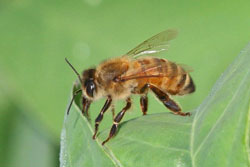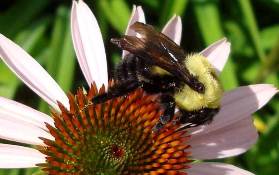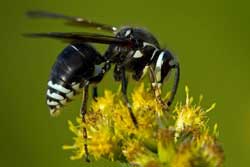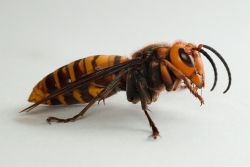Bees, Hornets and Wasps
Yellowjacket Wasps
Yellowjackets are beneficial insects that feed other insects to their larvae, often preying on insects that humans consider pests. Unfortunately, their ability to sting makes them a considerable health concern. Yellowjackets are responsible for about one-half of all human insect stings; they are easily provoked, and can sting more than once.
Yellowjacket wasps often become a nuisance from August through October, as they build up in large populations and scavenge for human food at picnics, cookouts, outside restaurants, bakeries, campsites, fairs, sports events and other outdoor get-togethers. Unless the threat of stings and nest location present a hazard, it is best to wait for freezing temperatures to kill off these annual colonies. Stinging workers do not survive the winter and the same nest is not reused.
Honey Bees
Honey bees are very important animals. Humans rely on them to pollinate crops, especially fruit trees; people also eat honey and use wax from honeycomb to make candles and other products. Honey bees usually leave people alone, but they are attracted to some soaps, perfumes and hairsprays. If one comes near you it is probably confused. Once it realizes you have no nectar it will leave you alone, but people do sometimes get stung stepping on bees.
Honey bees are not native to the United States, they were brought here from Europe in the 1600s. They compete with some native species of bees which are close to extinction due to this competition.
Bumble Bees
Bumble bees are important as pollinators. They can be aggressive around nesting sites but they are rarely aggressive during foraging activities. They occasionally become a problem when their nest is located next to a building or walkway. Like honey bees, bumble bees live in a colony where the adults care for the young (larvae) produced by a single queen. Bumble bee nests are small compared to honey bees, as each nest contains only a few hundred individuals.
Paper Wasps
Paper wasps are beneficial because they feed on insects considered pests by humans. They commonly build nests around homes, such as underneath eaves. Wasps attack when the nest is disturbed and each can sting repeatedly; stings typically cause localized pain and swelling, but in sensitive individuals or when many stings occur, more intensive reactions occur, including death.
Paper-like nests, shaped like tiny umbrellas, are suspended by a short stem attached to eaves, window frames, porch ceilings, attic rafters, etc. Each nest consists of a horizontal layer or "tier" of circular comb of hexagonal (six-sided) cells not enclosed by a paper-like envelope. The ends of the cells are open with the heads of the larvae exposed to view.
Baldfaced Hornets
The baldfaced hornet is a member of the yellowjacket family. They are aggressive and will attack anything (or anyone) that invades their space. They can sting repeatedly and their sting is very painful.
Baldfaced hornets build paper-like nests, which are grayish-brown, inverted, pear-shaped, and up to three feet tall with the nest entrance at the bottom. Each nest consists of a number of horizontal layers, stories or "tiers" of circular combs, one below the other completely enclosed by a paper-like envelope as a covering. Also, the cells are not exposed to view. Nest are built hanging from trees, bushes, vegetation and occasionally buildings.
Asian Giant Hornet
(Vespa mandarinia). This insect is not known to be established in the US, but following the discovery in 2019-2020 of two dead specimens in Washington state, this insect made news headlines. IT IS NOT KNOWN TO OCCUR IN MAINE! The Asian giant hornet is primarily a pest of honeybees, but like other hornets and wasps, Asian giant hornets can sting several times and its stings can be painful and potentially lethal to those allergic to its venom.
European Hornet
(Vespa crabro) has been established in the U.S. since the 1800’s. European hornets are very large wasps that look very similar to Asian giant hornets. They typically nest in dark cavities, usually hollow logs deep in the woods. People usually come into contact with this species in the spring when new queens are beginning to make nests or in the fall as workers change from capturing other insects to a scavenging lifestyle.
Eastern Cicada Killer Wasps
(Sphecius speciosus) is one of our largest native wasps. These large non-aggressive wasps build nests in the soil, often in lawns, and are commonly encountered during the summer months. Each female provisions her nest with cicadas she captures and paralyzes before laying an egg on each and placing it in the nest. The males can be territorial and may fly in a seemingly aggressive manner ‘buzzing’ intruders, but lacking a stingers, they are incapable of stinging.
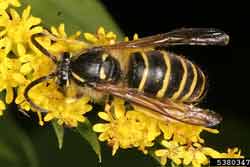
A typical yellowjacket worker is about 1/2-inch long, short and blocky, with alternating black and yellow bands on the abdomen, while the queen is about 3/4-inch long.

Paper wasps are 3/4 to 1 inch long, slender, narrow-waisted wasps with smoky black wings that are folded lengthwise when at rest. Body coloration varies with species.
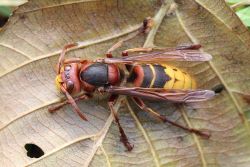
European giant hornet workers can grow to 1.25 inches and are often mistaken for Asian giant hornets. European giant hornet males cannot sting.
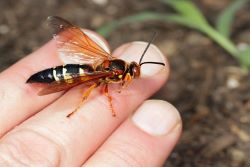
Adult eastern cicada-killer wasps are large, (0.6 to 2.0 in) long, robust wasps with hairy, reddish and black areas on the thorax (middle part), and are black to reddish brown marked with light yellow stripes on the abdominal (rear) segments.
Click on images to view full-size
Identification and Control Information
- Home & Garden Insect Series: Nuisance Wasps and Bees (PDF)— Colorado State University Extension
- Yellowjackets and Paper Wasps (PDF)— Washington State University Extension
- Asian Giant Hornet Lookalikes (PDF)— Xanthe Shirley— USDA APHIS Plant Protection & Quarantine
- Tips for Managing Yellowjackets (PDF)— Maine Integrated Pest Management Council
- Household Pest Management: Paper Wasps (PDF)— West Virginia University Extension Service
Information about Bees and Wasps as Beneficial Insects
- Pollinators: A Key to a Colorful World (PDF)— New Jersey Department of Agriculture and New Jersey Conservation Districts
- "What's Buzzin' in My Garden"— A Guide to Bees and Related Beneficial Insects
- Pollinator Plants for the Northeast Region— Xerces Society for Invertebrate Conservation
- Pollinators— United States Department of Agriculture, Forest Service
Want to Know More? More Information about Beneficial Organisms
[Photos, left to right: Gary Alpert, Harvard University, Bugwood.org; Johnny N. Dell, Bugwood.org; Gary Fish, Maine BPC; David Cappaert, Michigan State University, Bugwood.org; David Cappaert, Michigan State University, Bugwood.org]
